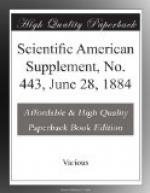The second cause of paint blistering from the ingredients of the paint happens between any layer of paint or varnish on wood, iron, stone, or any other substance. Its origin is the gaseous formation of volatile oils during the heated season, of which the lighter coal oils play the most conspicuous part; they being less valuable than all other volatile oils, are used in low priced japan driers and varnishes. These volatile oils take a gaseous form at different temperatures, lie partly dormant until the thermometer hovers at 90 deg. F. in the shade, when they develop into gas, forming blisters in airtight paint, or escape unnoticed in porous paint. This is the reason why coal-tar paint is so liable to blister in hot weather; an elastic, soft coal-tar covering holds part of its volatile oil confined until heated to generate into gas; a few drops only of such oil is sufficient to spoil the best painted work, and worse, when it has been applied in priming, it settles into the pores of the wood, needing often from two to three repetitions of scraping and repainting before the evil is overcome. Now, inasmuch as soft drying paint is unfit to answer the purpose, it is equally as bad when paint too hard or brittle has been used, that does not expand and contract in harmony with the painted article, causing the paint to crack and peel off, which is always the case when either oil or varnish has been too sparingly and turpentine too freely used. Intense cold favors the action, when all paints become very brittle, a fact much to be seen on low-priced vehicles in winter time. Damp in wood will also hasten it, as stated in blistering, the woodsap undermining the paint.
To avoid peeling and blistering, the paint should be mixed with raw linseed oil in such proportions that it neither becomes too brittle nor too soft when dry. Priming paint with nearly all oil and hardly any pigment is the foundation of many evils in painting; it leaves too much free oil in the paint, forming a soft undercoat. For durable painting, paint should be mixed with as much of a base pigment as it can possibly be spread with a brush, giving a thin coat and forming a chemical combination called soap. To avoid an excess of oil, the following coats need




